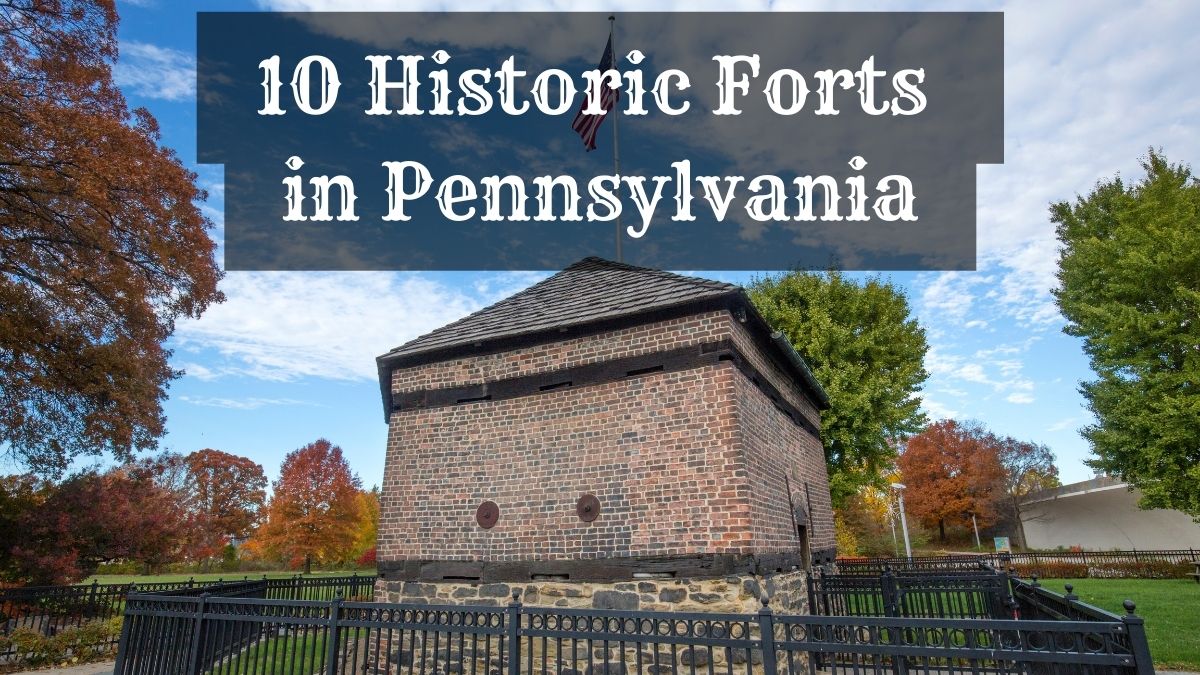Centered amidst Pennsylvania’s verdant hills and bustling cities lie monuments of a time when the territory was a battleground, a frontier, and a nexus of cultural exchange.
The historic forts in Pennsylvania stand as testaments to the state’s storied past — from the tumultuous days of the French and Indian War to the birth throes of the United States during the Revolutionary Era.
These enduring structures bear silent witness to the courage, ambition, and strategic cunning of the people who built, manned, and besieged them.
This article delves deep into the annals of history, offering readers a journey through Pennsylvania’s military architectural heritage, revealing tales of heroism, betrayal, and the relentless march of time. Join us as we explore the ramparts, fortifications, and stories shaping the Keystone State.
10 Historic Forts in Pennsylvania
| 1. Fort Ligonier | 6. Fort Machault |
| 2. Fort Pitt | 7. Fort Ralston |
| 3. Fort Mifflin (The Mud Island Fort) | 8. Fort Washington |
| 4. Fort Necessity | 9. Fort Duquesne |
| 5. Fort Fayette | 10. Fort Augusta |
1. Fort Ligonier
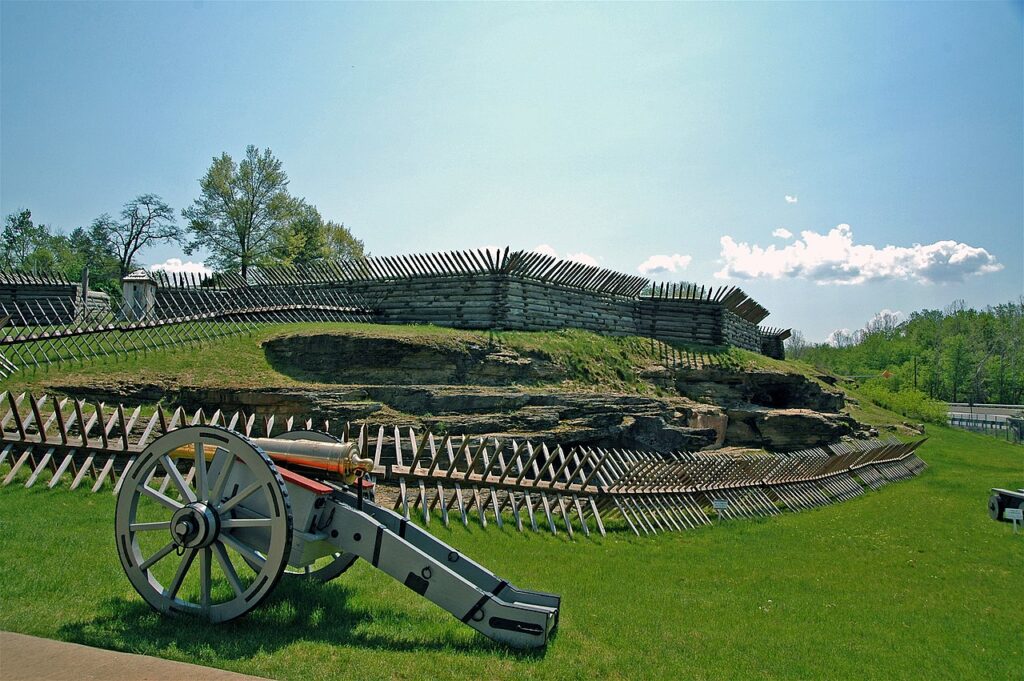
Fort Ligonier is located in the scenic expanse of Westmoreland County, a pivotal fortress that played an instrumental role during the tumultuous times of the mid-18th century, specifically during the French and Indian War (1754-1763).
Erected in 1758 under the orders of General John Forbes, this fortress was a beacon of protection in the Laurel Highlands and stood as a testament to the collaboration between British and colonial forces against shared threats.
Amidst the rolling landscapes of the Laurel Highlands, Fort Ligonier was meticulously designed as a strategic linchpin in the ongoing struggle for territorial dominance in North America.
Fort Ligonier was a critical supply and communication link in the British campaign to capture the French-held Fort Duquesne.
It provided a base for British forces, including notable figures like then-Lieutenant Colonel George Washington, who would later gain fame as the first President of the United States.
The interactions within its walls also showcased the complex and ever-evolving dynamics of the period. Soldiers from colonial militias and British regulars stood side by side, guarding against potential threats from French-allied Native American tribes.
The land they stood in had witnessed shifting allegiances, diplomatic negotiations, and military maneuvers, making the fort a significant player in the theater of 18th-century warfare.
Fort Ligonier Today
Today, as visitors walk the preserved ramparts of Fort Ligonier, they are invited into a world of strategic military planning, diplomatic endeavors, and the daily life of the soldiers who called it home.
The on-site museum offers a treasure trove of artifacts and displays, capturing the essence of the 1750s, while the gift shop provides tangible connections to a bygone era.
2. Fort Pitt
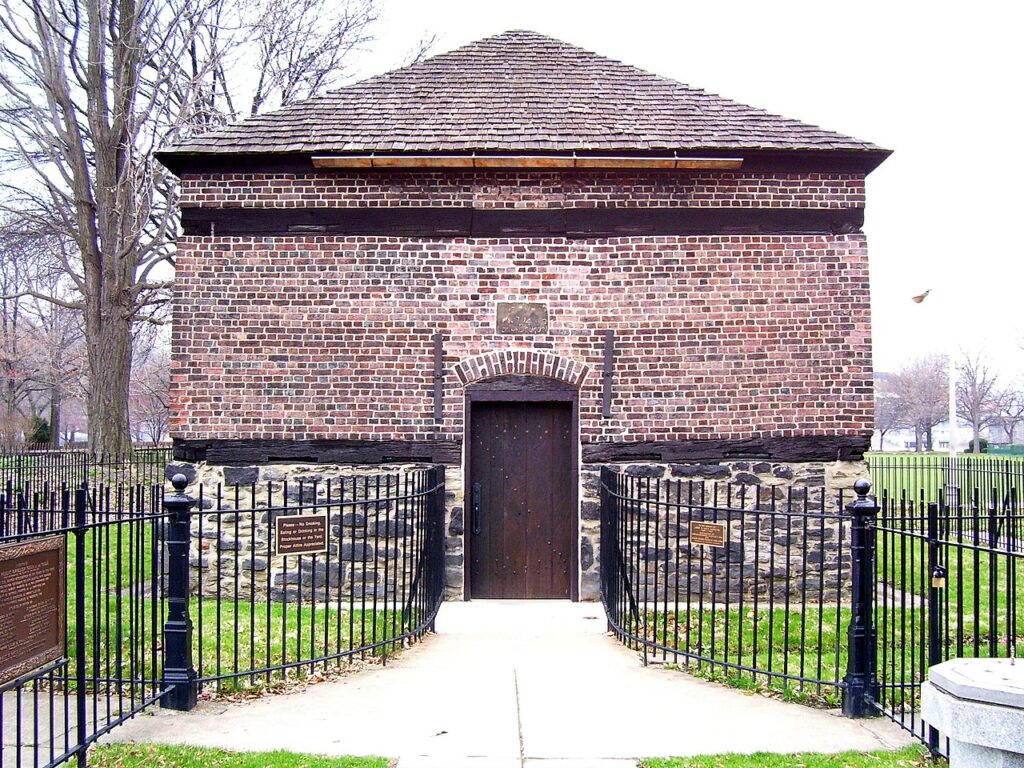
Fort Pitt stands on hallowed ground at the strategic juncture where the Allegheny and Monongahela Rivers merge to form the Ohio River.
Before its establishment, Fort Duquesne, a French outpost, marked this vital site during the turbulent times of the French and Indian War. The French recognized the importance of controlling this river junction and established Fort Duquesne as a bulwark against British expansion.
Pontiac’s Rebellion: A New Chapter
The significance of this location persisted even after the conclusion of the French and Indian War. Fort Pitt, built on the remnants of Fort Duquesne, soon found itself at the heart of another historical event: Pontiac’s Rebellion.
In the mid-1760s, the fortress became a focal point of conflict and diplomacy as Native American tribes, led by the influential Ottawa leader Pontiac, resisted British military presence and influence in the region. The fort’s garrison and inhabitants faced a prolonged siege, emphasizing its pivotal role in the post-war frontier.
The Fort Pitt Museum: Gateway to Western Pennsylvania’s Past
Today, the legacy of Fort Pitt and the land it occupies lives on in the heart of Point State Park. The Fort Pitt Museum stands as a beacon for history enthusiasts, providing a comprehensive insight into the multifaceted story of Western Pennsylvania.
From tales of Native American allies and their intricate relationships with colonial settlers to the presence of the British army and the dawning years of the United States, the museum captures the essence of a region shaped by conflict, cooperation, and cultural exchange.
3. Fort Mifflin (The Mud Island Fort)
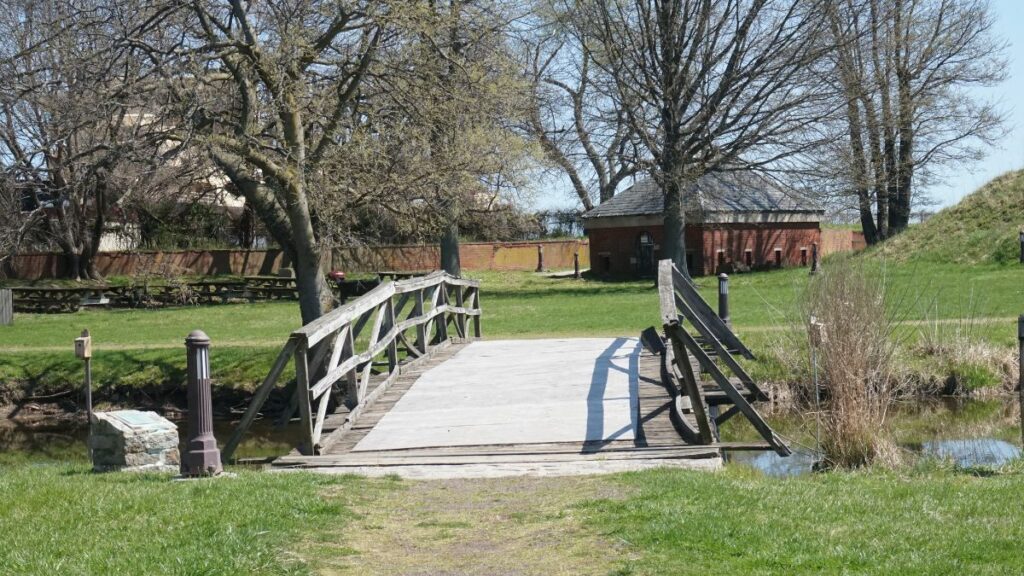
Positioned strategically on the Delaware River, Fort Mifflin’s moniker, the “Mud Island Fort,” gives a quaint contrast to its fierce historical significance. This island fortress has witnessed some of the most pivotal moments in American history and is a proud National Historic Landmark.
The Siege of 1777: A Testament to Resilience
Fort Mifflin’s prominence comes not just from its strategic location, but from the unforgettable events of the American Revolution. The fort earned its distinguished title due to its endurance during the most significant bombardment of the Revolutionary War.
In the Siege of 1777, its defenders put up a fierce resistance against British forces, drawing enemy attention and resources away from General George Washington’s beleaguered troops at Valley Forge. Despite overwhelming odds and devastating firepower, the fort’s garrison showcased a spirit of unyielding defiance and sacrifice.
Echoes of the Past: A Living Museum
Today, visitors meander through Fort Mifflin’s historic grounds and are transported back to the Revolutionary era. Every stone and cannon tells tales of bravery, strategy, and determination.
The fort offers a deep dive into military history, complemented by the serene and picturesque view of the Delaware River. The juxtaposition of nature’s calm with tales of explosive history makes Fort Mifflin a must-visit destination for history buffs and nature lovers alike.
4. Fort Necessity

Nestled in the heart of Southwestern Pennsylvania lies the Fort Necessity National Battlefield, a site steeped in history and national significance. Here, a young and ambitious George Washington took his first steps as a military leader, precursors to a journey that would later see him become the foremost figure in the American Revolution.
The Battle and the Birth of a Fort
At this very location, Washington, leading colonial troops, engaged in a skirmish against French forces and their Native American allies. This confrontation, while relatively small in the grand scope of military history, had ramifications that would resonate through the ages.
Following the battle, Washington and his troops hastily constructed Fort Necessity, a rudimentary but strategically vital stronghold.
While the engagement ended in a tactical defeat and a forced surrender for Washington, the events at Fort Necessity laid the groundwork for the more significant conflict that would become the French and Indian War, a precursor to the Revolutionary War.
Engaging with History: The Visitor Experience
Today, the Fort Necessity National Battlefield serves as more than just a historic site. The adjacent Fort Necessity Visitor Center enriches the experience, inviting guests to delve deeper into this formative period of American history.
Interactive displays, artifacts, and knowledgeable guides offer insights into the tactics employed, the key figures involved, and the geopolitical landscape of the era.
5. Fort Fayette

Situated in the heart of modern-day Pittsburgh, Fort Fayette’s legacy is intricately tied to the turbulent post-Revolutionary War period in the United States. During the closing years of the 18th century, the nascent U.S. government faced one of its first significant internal challenges: the Whiskey Rebellion.
The Role of Fort Fayette: An Essential Stronghold
Constructed by Major General Anthony Wayne in June 1792, Fort Fayette, initially Fort LaFayette, served as the primary base for federal troops sent to suppress the Whiskey Rebellion under the command of President George Washington.
The Rebellion, which erupted in response to a federal excise tax on whiskey, saw farmers and distillers in Western Pennsylvania take up arms against what they perceived as fiscal oppression.
The fort acted as a military stronghold and symbol of the new federal government’s authority and willingness to ensure compliance with its laws.
The Legacy Preserved: From Rebellion to Modernity
While the physical structures of Fort Fayette have long disappeared, its historical significance endures. The fort’s establishment marked one of the earliest assertions of federal authority within U.S. borders, setting a precedent for the government’s role in internal disputes.
Today, the site serves as a reminder of the delicate balance between governmental power and civil liberties, which remains relevant in contemporary discussions.
6. Fort Machault
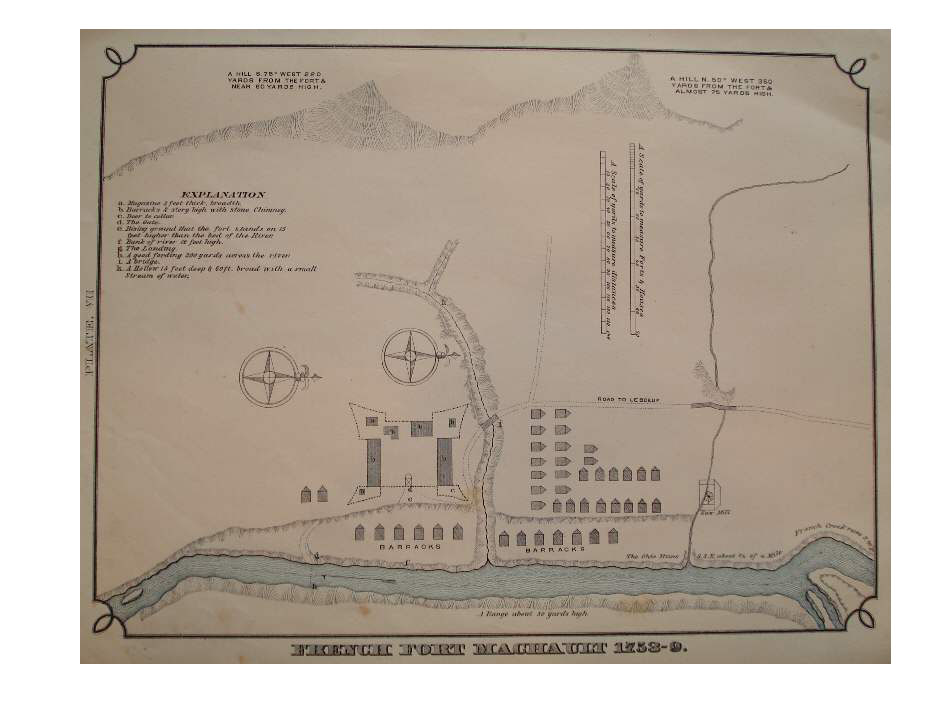
Positioned strategically along the flowing waters of the Allegheny River, Fort Machault is a testament to French colonial ambitions in North America.
Named in honor of Jean-Baptiste Machault d’Arnouville, a notable French engineer and minister of the Marine, this fortification was a linchpin in the French defense system during the turbulent times of the French and Indian War.
A Key Component: The French Creek Defense System
The French developed an elaborate defense system to secure and control vast territories, leveraging the natural waterways for protection and communication.
Fort Machault, as part of this system, played a significant role in the chain of forts along French Creek, serving as a conduit between Lake Erie and the Allegheny River. This position offered the French a strategic advantage and acted as a formidable deterrent to British advancements.
Confrontation and Legacy: The Struggle for Supremacy
While the fort’s walls witnessed the daily routines of soldiers and traders, they also witnessed the mounting tensions between the French and British empires.
As the two European powerhouses vied for control over the lucrative North American territories, Fort Machault found itself in the crosshairs. Engagements between the fort’s French garrison and British forces revealed the broader geopolitical struggle, highlighting the fort’s crucial role in this historical narrative.
Today, visitors to the area where Fort Machault once stood can immerse themselves in a rich tapestry of history. Through remnants, plaques, and interpretive centers, the tales of brave soldiers, fierce battles, and the ever-changing landscape of colonial America come alive, offering a window into a pivotal chapter of the continent’s past.
7. Fort Ralston
Berks County, with its rich landscapes and burgeoning settlements, was not immune to the perils of the 18th-century American frontier.
As settlers pushed further into territories previously inhabited by Native American tribes, the need for protection became paramount. Rising to meet this challenge was Fort Ralston, a beacon of safety in an era marked by uncertainty and conflict.
Guarding the Frontier: A Bulwark against Threats
Named after its possible founder or a notable figure of its time, Fort Ralston stood as a protective shield for the settlers in Berks County.
Its establishment primarily reacted to the periodic hostilities and raids by Native American tribes during the Indian War. As a strategic fortification, Fort Ralston was vital in ensuring that the settlers, their families, and their livelihoods remained safe from potential threats.
Echoes of the Past: Rediscovering Fort Ralston Today
Time may have eroded the physical structures of Fort Ralston, but its legacy endures. While little remains of the fort’s original battlements and walls, the site remains a touchstone for those keen on exploring the region’s history.
Modern visitors can wander the grounds, piecing together the fort’s story from the scattered remnants and informative markers. The experience is a journey back in time, offering insights into the challenges faced by early American settlers and the strategic importance of frontier forts.
8. Fort Washington

As the winds of rebellion swept across the thirteen colonies, the need for fortified positions to resist British advancements became evident.
Fort Washington, meticulously constructed by the Continental Army in Chadds Ford, was born from this strategic necessity. Its establishment symbolized the colonies’ commitment to their revolutionary cause and readiness to defend their newfound liberties.
Strategic Significance: Under General Washington’s Aegis
Guided by the military understanding of General George Washington, Fort Washington quickly emerged as a pivotal asset in the broader Revolutionary War campaign.
Its strategic location in Chadds Ford offered the Continental Army a vantage point, allowing them to monitor and counteract British movements. The fort’s role transcended mere defense; it symbolized the tenacity and resolve of the revolutionary forces.
Bridges to the Past: Fort Washington within the Revolutionary Landscape
Today, Fort Washington stands in esteemed company, flanked by historical titans like Valley Forge National Historical Park and Independence Hall.
When taken collectively, these sites offer a comprehensive narrative of the trials, tribulations, and triumphs that marked America’s journey toward independence.
Visitors to Fort Washington can witness firsthand the location’s strategic importance and draw connections to other crucial events and locations that shaped the Revolutionary War.
9. Fort Duquesne

In the heart of the North American continent’s strategic waterways, where the Allegheny and Monongahela Rivers converge to form the Ohio River, stood Fort Duquesne.
Established by the French during the mid-18th century, this fortification was a testament to France’s ambitions to maintain control over the lucrative fur trade routes and assert dominance in the Ohio River Valley.
A Crucible of Empires: The Anglo-French Rivalry
As the European powers expanded their colonial territories, the Ohio Valley became a focal point of contention. Fort Duquesne, in particular, was central to the escalating tensions of the French and Indian War.
Its presence posed a direct challenge to British colonial aspirations. The fort witnessed numerous skirmishes and confrontations, most notably involving a young British emissary and militia officer, George Washington, in the events leading to the war.
Transition and Legacy: From Duquesne to Pitt
Fort Duquesne’s French era was short-lived despite its initial robustness and strategic significance. Threatened by advancing British forces and faced with logistical challenges, the French abandoned and destroyed the fort in 1758.
In its place, the British erected Fort Pitt, a more formidable structure that would play a crucial role in shaping American history.
Today, the site of Fort Duquesne is enveloped by the modern urban landscape of Pittsburgh, yet its historical resonance remains palpable. Markers and installations serve as reminders of the fort’s pivotal role in the epic struggle for control over North America.
10. Fort Augusta

Perched along the west bank of the Susquehanna River, in what is now modern-day Sunbury, Fort Augusta stood as one of Pennsylvania’s most formidable British fortifications.
Built in 1756, during the heart of the French and Indian War, its primary purpose was to guard the crucial frontier settlements and serve as a strategic base for military operations in the northern and western frontiers of the colony.
Role and Significance: A Bastion against Threats
As British settlements grew, they often encroached upon Native American territories, leading to inevitable clashes.
Fort Augusta was built to safeguard these frontier communities from potential raids and incursions, primarily by Native American tribes allied with the French. Its formidable design — complete with a bastioned stone wall and artillery pieces — ensured it never fell to an attack, making it a beacon of security for settlers.
Post-War Legacy and Modern Reverence
With the conclusion of the French and Indian War, Fort Augusta continued to play a vital role, serving as a military and trading post during the American Revolution. Over time, as threats subsided and the region became more settled, the fort’s significance waned. However, its legacy persisted.
Today, remnants of Fort Augusta, including portions of its original walls and a reconstructed blockhouse, offer visitors a tangible connection to Pennsylvania’s tumultuous frontier past. The nearby Northumberland County Historical Society provides insights and exhibits on the fort’s rich history and its role in shaping the Commonwealth’s legacy.
Related: 10 Historic Forts in South Carolina
Pennsylvania Military History
Gettysburg National Military Park
Gettysburg National Military Park is a significant site in American military history, as it was a crucial battleground during the Civil War. The park commemorates the heroism and sacrifices the Union and Confederate armies made.
Visitors can explore this historic site with numerous monuments, markers, and exhibits. The park’s visitor center offers guided tours, interpretative programs, and a museum featuring Civil War artifacts.
Battlefields
Pennsylvania boasts numerous historically significant battlefields. The Monongahela River was the location of an important conflict during the French and Indian War, and the Chadds Ford area witnessed the Revolutionary War’s Battle of Brandywine. I
In addition, the state’s southwestern region is where the Bushy Run Battlefield Park is found, commemorating a significant victory during Pontiac’s Rebellion in 1763.
Historic Park Services
The National Park Service, in collaboration with the Pennsylvania Historical and Museum Commission, preserves and operates various military history sites in Pennsylvania.
Their efforts have led to the creation and maintaining monuments and exhibits at places like Valley Forge National Historical Park. These parks provide a wealth of information for visitors interested in exploring Pennsylvania’s military history.
Erie Maritime Museum
The Erie Maritime Museum offers an excellent opportunity to learn about Pennsylvania’s naval history. The museum focuses on stories of the state’s involvement in naval battles during the 18th and early 19th centuries.
Among the many exhibits, the museum showcases details about naval conflicts on the Great Lakes and the construction of naval fleets in the region. The museum also features the USS Niagara, a ship pivotal in the Battle of Lake Erie during the War of 1812.
Pennsylvania Historical and Museum Commission
The Pennsylvania Historical and Museum Commission (PHMC) works diligently to preserve, research, and promote the state’s numerous historic sites and resources.
In partnership with organizations like the National Park Service, the PHMC has been instrumental in preserving and operating military history sites throughout Pennsylvania. These efforts give visitors access to battlefields, forts, and museums that testify to the state’s rich military and cultural history.
The PHMC specifically played a crucial role in preserving key sites like Fort Mifflin and Fort Ligonier, which were instrumental during the Revolutionary War, and Fort Necessity, which saw action during the French and Indian War.
In addition, the Commission provides resources through publications and online databases, aiding researchers and historians who dig into Pennsylvania’s military past.
Conclusion – Historic Forts in Pennsylvania
In the tapestry of Pennsylvania’s storied past, its historic forts are resilient markers of ambition, conflict, and transformation. From the banks of the Allegheny to the stretches of the Susquehanna, these fortifications witness the state’s pivotal role in the larger narrative of North American history.
As sentinels of bygone eras, they encapsulate Pennsylvania’s military and strategic endeavors and serve as enduring reminders of the sacrifices and triumphs that shaped the very foundations of America.
Whether one is a history enthusiast or a casual visitor, the forts of Pennsylvania offer a rich and immersive journey into the annals of a nation’s birth and evolution.
If you have visited any of these forts in Pennsylvania, we would love to hear about your experience in the comments section below. Thanks for reading!

Cory is a website owner and content creator who enjoys fishing, history, coin collecting, and sports, among other hobbies. He is a husband and father of four.
Romans 15:4 For whatever was written in former days was written for our instruction, that through endurance and through the encouragement of the Scriptures we might have hope.

